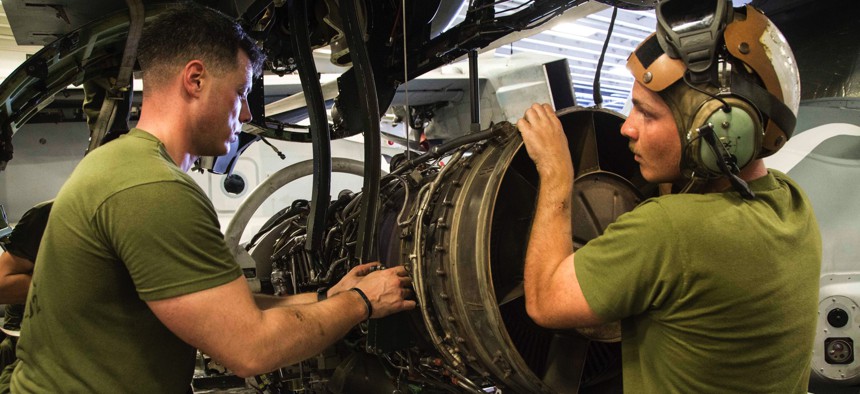
U.S. Marine Corps maintainers adjust cables on an engine of an MV-22 Osprey in the hanger bay of the USS Makin Island in 2016. U.S. Marine Corps / Cpl. April L. Price
US clears Ospreys to fly, with new maintenance plan and one enduring mystery
Each service has its own path to resume operations after a two-month grounding.
The U.S. military has cleared its fleet of V-22 Ospreys to fly again, though officials say they still don’t know why a critical part failed.
The tiltrotor fleet was grounded on Dec. 6, a week after a “materiel failure” caused an Air Force CV-22 to crash off the coast of Japan, killing eight airmen.
“Based on engineering analysis we are confident that the mitigations put in place with the safety controls allow us to resume flying while the [Joint Program Office] continues testing for additional information to root cause,” an Air Force Special Operations Command spokesperson said Friday.
Maintenance changes have been made to address the failure and all three services will have their own return-to-flight plans, according to a statement from Naval Air Systems Command.
The Air Force is using a “three-phased” approach to return to flight and it will be a gradual ramp-up before they resume full operations, AFSOC said in a statement.
First, AFSOC will conduct “ground and simulator training integrating planned flight controls, safety briefings, a review of maintenance records and refining by-squadron training plans to implement the new safety protocols.” The second phase is a “multi-month program” for aircrew and maintainers to regain “basic mission currency,” according to AFSOC. That will pave the way for the service to resume full operations in the third phase.
“This phased approach affords AFSOC the time required to maximize opportunities to learn as much as possible from the Safety Investigation Board and Accident Investigation Board to mitigate risk to our aircrew, maintainers, and joint partners,” AFSOC said.
Ahead of the announcement, Rep. James Comer, R-Ky., chair of the House Oversight Committee, criticized the Pentagon for lifting the grounding order without providing answers about the safety of the aircraft.
“The House Oversight Committee has yet to receive adequate information requested from DOD as part of our ongoing investigation launched months ago into the safety and performance of the Osprey aircraft. Serious concerns remain such as accountability measures put in place to prevent crashes, a general lack of transparency, how maintenance and operational upkeep is prioritized, and how DOD assesses risks,” Comer said in the statement.
Meanwhile, a retired Marine two-star recently urged leaders not to buy into any narrative of the V-22 as unsafe.
“In fact, the Osprey is a modern marvel in terms of performance and capability, and its operational safety record is on a par with the most widely used conventional rotorcraft flying in the Department of Defense today,” Steve Busby, a former commanding general of 3d Marine Aircraft Wing, wrote in Defense One.




